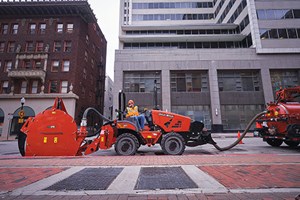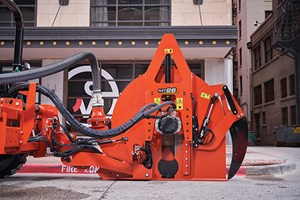May 2022 Vol. 77 No. 5
Features
Microtrenching: Faster, Cost-Effective Solution for Fiber Installation
Scott McKinley
Demand for fiber-optic and cable installation is high, and it’s no surprise, as the ability to stay connected has never been more important. Meeting this demand calls for fast turnaround times, even in the face of ongoing challenges, like the labor shortage.
Microtrenching can provide a faster, cost-effective method for installation, particularly in congested urban areas. It offers contractors the best of both worlds: the efficiency of traditional techniques with the simple clean-up of a trenchless application.
A systems approach, it involves combining a host machine with a microtrenching attachment, blade and vacuum excavation system. It’s a one-stop shop for installation that minimizes traffic disruption, potential fees and permits, and spoils disposal needs – all of which significantly reduce the cost per foot. The entire solution works as one to help contractors own the job site and stay profitable.
Here’s how it works.
Microtrencher function, benefits
The big question for fiber-optic and cable installation remains consistent: what’s beneath the surface?
Whether the job is in a sprawling, well-established city or newer residential area, there will always be a patchwork of buried utilities and natural ground obstacles to navigate. Additionally, many neighborhoods and developments such as business parks are not built in straight, easily navigable lines. Trying to safely operate around the man-made and natural terrain can decrease speed and productivity.
Microtrenching is designed to tackle these issues head-on, cutting a narrower, shallower trench that gets under the upper layer of solid ground, while reducing the likelihood of interference with most existing underground utilities. The low-impact process is achieved by pairing a microtrencher attachment with a host machine, such as a stand-on skid steer or ride-on trencher.
This equipment can dig a trench ranging from 0.375 inches to 3 inches wide and 6 inches to 26 inches deep, depending on the equipment and the need. Microtrenchers also are designed to provide more maneuverability on the job site, enabling operators to efficiently cut on a street corner or around a cul-de-sac. While equipment can vary, microtrenchers can swing several degrees in each direction.
When it comes to choosing a stand-on skid steer or ride-on trencher, the size of the job is the most important factor. Most operators will only want to stand on the back of a skid steer for so long. And, as the distance increases, it becomes more cost-efficient to select the larger ride-on trencher. The larger the machine, the more power to the attachment, allowing it to cover more ground in less time.
There can be flexibility in how the equipment is used. If a microtrencher attachment is installed on a ride-on trencher, the unit will perform like a dedicated machine, and many contractors will choose to keep using it as such. If desired, however, the attachment can be replaced with a trencher, plow, saw or new microtrencher, making the unit more versatile and valuable.
Key components
The appropriate blade is also a critical component of a microtrenching solution, as different ground conditions impact blades differently. The harder or more abrasive the material, the faster the blades or teeth will wear, which can cause delays and negatively impact productivity.
Most microtrenchers use one of two blades: conical or polycrystalline diamond compact (PDC). A conical blade rotates in a holder and functions like a traditional rock saw. Conical bits generally are more affordable, but they have a limited lifespan. Most will be effective through several hundred feet, meaning contractors will need to replace them daily.
PDC blades are becoming more popular because they have a cleaner cut and can last more than 10,000 feet before needing to be replaced. Both types of blades are designed with the intent of making it fast and easy to replace in the field. Operators should be able to make the change in about 5 to 10 minutes using basic hand tools.
A vacuum excavator is another critical component – and one that impacts blade longevity. It works alongside the microtrencher to clean while cutting, helping remove debris in the trench prior to filling and allowing the grout used to stick to the surface. In the process, it also assists in locating and exposing existing utilities in the trench path. Both aspects serve as important differentiators between microtrenching and other open-cut solutions.
The type of vacuum excavator used is an important consideration. A dealer can help identify the right system, which can vary based on the size of the job and soil type. Ensuring the proper level of suction is key; if the microtrencher is recutting the same spoils over and over, the blade will wear out a lot faster.
A good rule of thumb is to select a system with a suction force of at least 1,000 cubic feet of air per minute (CFM). Another feature is the port size. Some microtrenchers are equipped to support varying port sizes, creating flexibility for contractors to choose their own vacuum excavator.
For new equipment to deliver the greatest benefits, contractors need a crew prepared to operate it – and that’s not something that can be taken for granted right now. Fortunately, microtrenching solutions don’t require as extensive training as other technologies, allowing new operators to get up to speed quickly and offering greater continuity of operations as crew members come and go.
With increased levels of demand for fiber-optic and cable installation, contractors need solutions that increase productivity and cost-efficiency. From the precision of the equipment to the flexibility of operation, microtrenching is an innovative example uniquely suited to today’s job sites. •
ABOUT THE AUTHOR: Scott McKinley is a product manager for fiber optic installations with Ditch Witch.
FOR MORE INFORMATION:
Ditch Witch, (800) 654-6481, ditchwitch.com






Comments